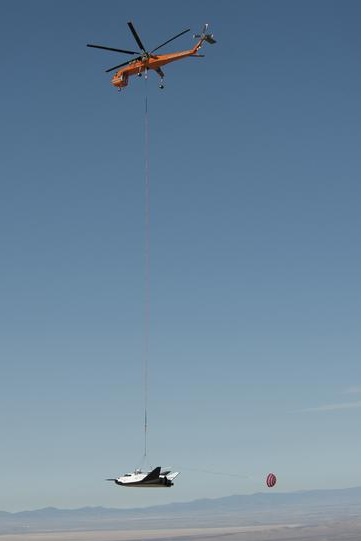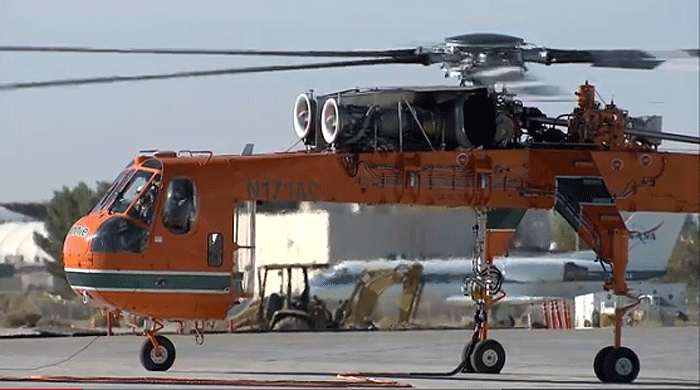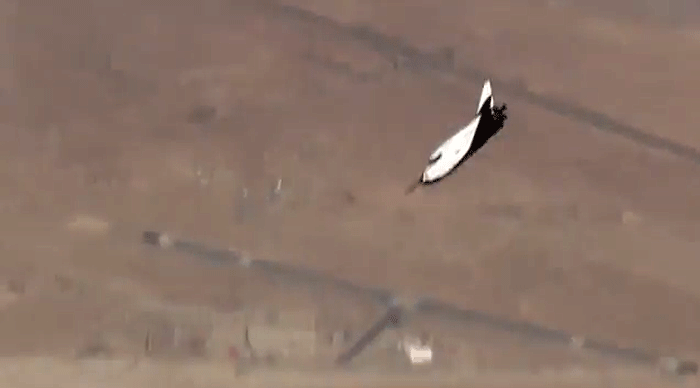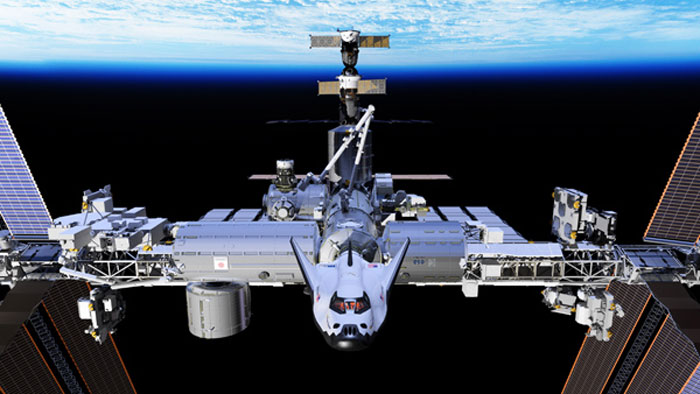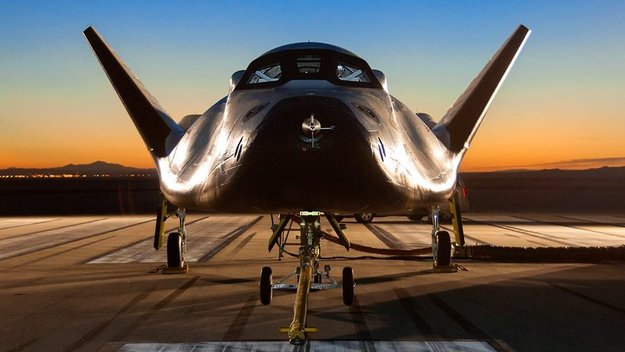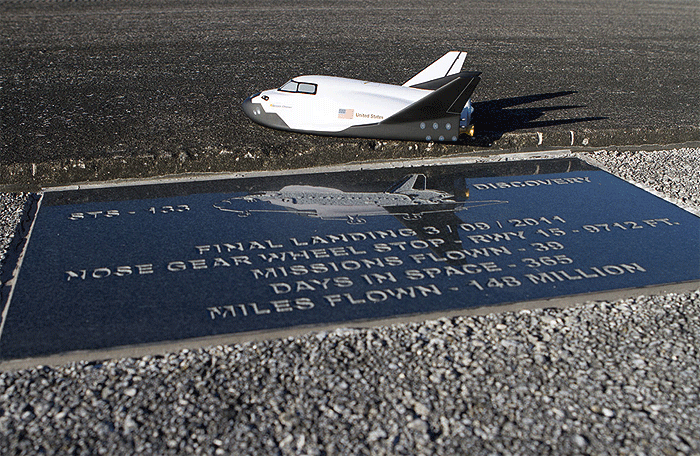Kern County is no stranger to spaceships and rocket scientists.
From Chuck Yeager breaking the sound barrier in 1947 to the first manned private spaceflight by SpaceShipOne in 2004, eastern Kern has established a solid reputation as the Kitty Hawk of aerospace.
Kern County... it's time to meet Dream Chaser.
Developed by Sierra Nevada Corp. of Louisville, Colo. -- in partnership with NASA -- the Dream Chaser is a vertical-takeoff, horizontal-landing spaceplane that is expected to provide NASA with a safe, commercially-operated transportation service to the International Space Station and back again.
The seven-passenger spacecraft is still in its early testing stages, and on Thursday, a test version of the craft successfully completed a captive-carry test at NASA's Dryden Flight Research Center in eastern Kern County, according to twin news releases from NASA and Sierra Nevada Corp.
During the two-hour test, an Erickson Air-Crane helicopter picked up a test version of the Dream Chaser flight vehicle and flew it a distance of three miles over a dry lake bed at Edwards Air Force Base at a maximum altitude of about 12,400 feet.
The spacecraft followed the projected path it will fly during future approach and landing tests at Dryden, the releases said.
The spaceplane's flight computer, along with its guidance, navigation and control systems were tested, NASA said in its release. The landing gear and nose skid also were deployed during flight.
"Today is the first time we have flown a fully functional Dream Chaser flight vehicle, and we are very pleased with the results," said Mark Sirangelo, corporate vice president and head of Sierra Nevada's Space Systems.
This was the second captive-carry test of the Dream Chaser flight vehicle and its first at Dryden. Data obtained from the test will provide valuable information about the vehicle's hardware and ground operations. The test paves the way for upcoming free-flight tests at Dryden this fall as part of the company's agreements with NASA.
According to the release, Dream Chaser will ultimately launch atop an Atlas V rocket. Commercial human flight capability has been projected to begin as early as 2016.
Quelle: The Bakersfield Californian
.
Update: 28.10.2013
.
Dream Chaser suffers landing gear failure after first flight
.

Sierra Nevada Corporation’s Dream Chaser ETA (Engineering Test Article) conducted her maiden flight at the Dryden Flight Research Center on Saturday. However, the Commercial Crew prospect – after enjoying a perfect flight in the air – suffered a mechanical failure during landing, resulting in her flipping over on the runway.
.
Known as the approach-and-landing free-flight test, Saturday saw the ETA taken on one final captive carry test, ensuring everything on the vehicle was nominal, prior to the test proper.
The start of the test was slightly delayed due to airspace requirements, beginning at 9:45am local time.
See Also
Commercial Crew Forum
L2 Future Vehicles Section
L2 Dream Chaser Special
Click here to Join L2
With all systems classed as nominal, the command was given to release Dream Chaser via the electrically actuated attach points on the ETA.
Flying on her own for the first time, Dream Chaser enjoyed a period of free-flight, as she began her glide towards the lake bed, prior to making the final approach she will hope to conduct with a crew onboard in the coming years.
Dream Chaser’s approach during a real mission will be targeting a landing speed of 191 knots, after re-entering the atmosphere protected by a Thermal Protection System (TPS) that is similar to that on the Space Shuttle.
The conclusion to her missions will see her touch down on two Main Landing Gear (MLG) just like the shuttle orbiters. However, there is one major difference when the nose is pitched forward, given the Dream Chaser will not be using a traditional Nose Landing Gear (NLG) wheel for its rollout.
Instead, an inbuilt skid strip is employed for completing the touchdown and rollout sequence. SNC have previously noted to NASASpaceFlight.com that this system is a simple, light, safe option.
During the test on Saturday, all systems performed admirably during the free flight, following release from the Erickson Air-Crane helicopter at 11:10am local time.
“Following release, the Dream Chaser spacecraft automated flight control system gently steered the vehicle to its intended glide slope. The vehicle adhered to the design flight trajectory throughout the flight profile. Less than a minute later, Dream Chaser smoothly flared and touched down on Edwards Air Force Base’s Runway 22L right on centerline,” added SNC in a later release.
However, via what is being classed as a mechanical failure of the left landing gear (failure to deploy), the ETA lost control when “weight on wheels”, and flipped over on the runway. The focus appears to be on the landing gear door, which failed to open.
Notably, the main landing gear on the ETA is not the same as what set to be employed on future Dream Chasers.
“While there was an anomaly with the left landing gear deployment, the high-quality flight and telemetry data throughout all phases of the approach-and-landing test will allow SNC teams to continue to refine their spacecraft design,” added the company.
There is currently no confirmed information on the level of damage on the vehicle, or if she can be repaired.
“SNC and NASA Dryden are currently reviewing the data. As with any space flight test program, there will be anomalies that we can learn from, allowing us to improve our vehicle and accelerate our rate of progress.”
Quelle: NASA-Spaceflight
.
Statement from Sierra Nevada Corporation Regarding Dream Chaser© Free-Flight Test
Sparks, NV – October 26, 2013 – Today, Sierra Nevada Corporation (SNC) performed its first free-flight approach-and-landing test of the Dream Chaser® spacecraft. The vehicle successfully released from its carrier aircraft, an Erickson Air-Crane helicopter, as planned at approximately 11:10 a.m. Pacific Standard Time. Following release, the Dream Chaser spacecraft automated flight control system gently steered the vehicle to its intended glide slope. The vehicle adhered to the design flight trajectory throughout the flight profile. Less than a minute later, Dream Chaser smoothly flared and touched down on Edwards Air Force Base’s Runway 22L right on centerline. While there was an anomaly with the left landing gear deployment, the high-quality flight and telemetry data throughout all phases of the approach-and-landing test will allow SNC teams to continue to refine their spacecraft design. SNC and NASA Dryden are currently reviewing the data. As with any space flight test program, there will be anomalies that we can learn from, allowing us to improve our vehicle and accelerate our rate of progress.
.
.
Update: 30.10.2013
.
Dream Chaser mini-shuttle to be fixed after first free flight
.

Sierra Nevada video shows Dream Chaser's descent but stops short of touchdown.
.
Sierra Nevada Corp. says its Dream Chaser prototype space plane will fly again after Saturday's first-ever glide test — a largely successful outing that was marred by a landing-gear failure.
The failure caused the 23-foot-wide (7-meter-wide) unmanned mini-shuttle to tip over, veer off its landing strip at Edwards Air Force Base in California and sustain some damage. "It wound up on its landing gear," Mark Sirangelo, corporate vice president for SNC Space Systems, told NBC News.
The company released a video on Tuesday that showed the unmanned Dream Chaser's release from its carrier helicopter, its autonomously controlled descent to the strip, and the failure of the left landing gear to deploy. The video stopped short of showing the landing itself, however. Sirangelo said that part of the video was being held back for a post-accident investigation.
During a teleconference on Tuesday, Sirangelo said the vehicle was "repairable and [would be] flyable again." There was no damage to the test vehicle's internal shell or electronics, and the damage to the external carbon-composite shell can be fixed, he said. The only question is whether the Dream Chaser would be repaired for another autonomous flight, or retooled for its first piloted flight. Either way, the vehicle would fly again later this year or next year, Sirangelo said.
"Our timeline isn't going to be affected by this," Sirangelo said. The flight yielded so much good data about Dream Chaser's aerodynamics that "in a strange way [it] might actually accelerate the program," he said.
.
.
On October, 26, 2013 Sierra Nevada Corporation (SNC) performed its first free-flight approach-and-landing test of the Dream Chaser® spacecraft. The vehicle successfully released from its carrier aircraft, an Erickson Air-Crane helicopter, as planned at approximately 11:10 a.m. Pacific Standard Time. Following release, the Dream Chaser spacecraft automated flight control system gently steered the vehicle to its intended glide slope. The vehicle adhered to the design flight trajectory throughout the flight profile. Less than a minute later, Dream Chaser smoothly flared and touched down on Edwards Air Force Base's Runway 22L right on centerline. While there was an anomaly with the left landing gear deployment, the high-quality flight and telemetry data throughout all phases of the approach-and-landing test will allow SNC teams to continue to refine their spacecraft design. SNC and NASA Dryden are currently reviewing the data. As with any space flight test program, there will be anomalies that we can learn from, allowing us to improve our vehicle and accelerate our rate of progress. Please continue to monitor.
.
.
.
.
.
.
.
.

Sierra Nevada Corp.'s Dream Chaser prototype space plane comes in for a landing at Edwards Air Force Base in California. The right landing gear and a central landing skid can be seen, but the left landing gear did not deploy - leading to a tumble that damaged the vehicle.
.
Sirangelo stressed that the landing gear used during Saturday's test was adapted from the equipment for an F-5 fighter jet, and would not be used on future configurations of the test vehicle.
NASA is due to pay Sierra Nevada $227.5 million during the current phase of development for the Dream Chaser, as part of a development program aimed at having U.S.-built spaceships ready to carry U.S. astronauts to the International Space Station by as early as 2017. NASA is supporting parallel development programs at the Boeing Co. and SpaceX, to the tune of more than $1 billion in total.
The Dream Chaser is the only one of the three proposed spacecraft that would be a winged vehicle. It's designed for launch atop an Atlas 5 rocket with up to seven passengers aboard, and landing at NASA's Kennedy Space Center in Florida. Sirangelo said Sierra Nevada is aiming to conduct an autonomous orbital flight test in 2016, with a piloted test expected during the latter half of 2017.
NASA's agreement calls for Sierra Nevada to receive an $8 million payment for collecting data relating to the Dream Chaser's flightworthiness. "NASA gets 30 days after we submit the data for a milestone to make the determination as to whether or not we've met that. ... We believe we've met all the criteria, but at this time I can't make a definitive statement. That's for NASA to do," Sirangelo told NBC News.
NASA has not yet commented on that point. On Saturday, the space agency said representatives from Sierra Nevada, NASA's Dryden Flight Research Center and the Air Force were "looking into the anomaly" that occurred during landing, and that Sierra Nevada would release information as it became available.
Quelle: NBC
.
Update. 17.12.2013
.
Sierra Nevada Corporation Completes CCDev2 Contract with NASA
Company begins Dream Chaser Flight Test Program
.
SPARKS, Nev., Dec. 16, 2013 –Sierra Nevada Corporation (SNC) today announced that the company has successfully completed all milestones under NASA’s Commercial Crew Development 2 (CCDev2) phase. Milestones achieved include a systems requirement review, flight simulator development, creation of a vehicle avionics integration laboratory, system definition review, flight control integration laboratory, preliminary design review and the first free-flight test of the Dream Chaser® spacecraft.
The final milestone, free-flight test Milestone 13, was executed Oct. 26, 2013 at Edwards Air Force Base in Edwards, Calif., in conjunction with NASA’s Dryden Flight Research Center. The objective of the milestone was to lift the Dream Chaser spacecraft via a carrier vehicle to its designated release conditions then release the spacecraft for an unpiloted free-flight test in order to collect trajectory data during flight.
All expected trajectory and flight data, including the nominal glide slope and other aerodynamic data, were successfully demonstrated and collected in-flight. The Dream Chaser spacecraft’s performance during flight exceeded predictions and requirements. After extensive post-flight analysis by NASA, SNC received the full award value for the milestone. The free-flight test of the flexible, lifting-body vehicle marked the culmination of years of design and scale model testing completed by SNC and NASA’s Langley Research Center on both the SNC Dream Chaser vehicle and the heritage NASA vehicle, the HL-20.
"SNC is pleased to begin flight testing and to have successfully completed the CCDev2 agreement with passage of this most recent milestone,” said Mark Sirangelo, corporate vice president and head of SNC’s Space Systems. “Having the Dream Chaser flight exceed our expectations on its first autonomous flight was an extraordinary accomplishment for SNC, its team of industry, government and university partners, and all those who worked on the NASA heritage HL-20 vehicle that Dream Chaser is based on.
With CCDev2 now complete, SNC is committed to meeting all contracted milestones under its on-going agreement with NASA’s Commercial Crew Program (CCP) during the Commercial Crew Integrated Capability (CCiCap) initiative.
“We thank NASA for the tremendous support we have received over the life of the CCDev2 agreement and look forward to continuing our strong working relationship in building the next-generation crew transportation vehicle,” Sirangelo said. “Our goal is to restore America's leadership in human spaceflight and completing CCDev2 was a critical step along that path.”
SNC is working with CCP as the company develops a next-generation crew transportation vehicle. Dream Chaser is the only reusable, lifting-body human spacecraft with a commercial runway landing capability, anywhere in the world. The Dream Chaser spacecraft is on the forefront of the commercial human spaceflight industry, offering safe, reliable and cost-effective crew and critical cargo transportation to low-Earth orbit.
.
Quelle: SNC
.
Rückblicke auf Dream Chaser RollOut und Test


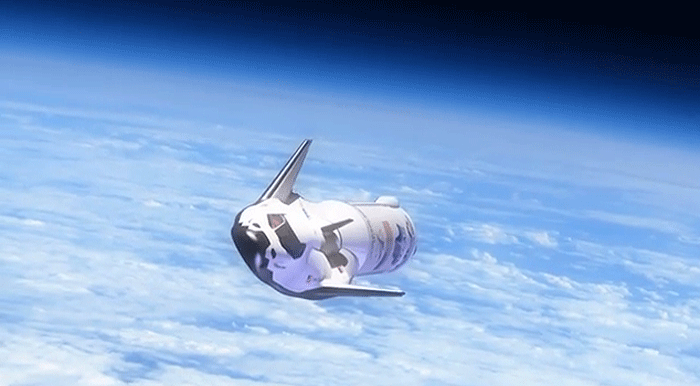






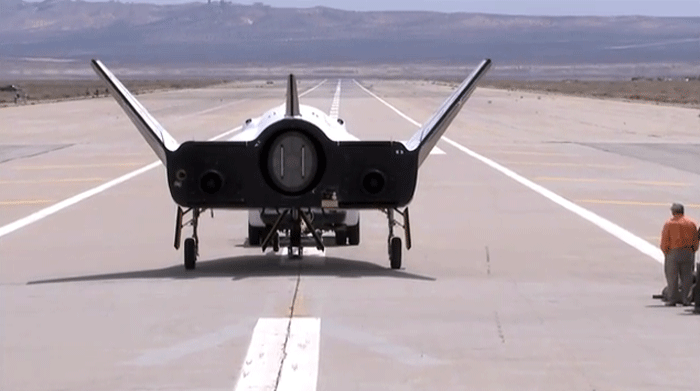
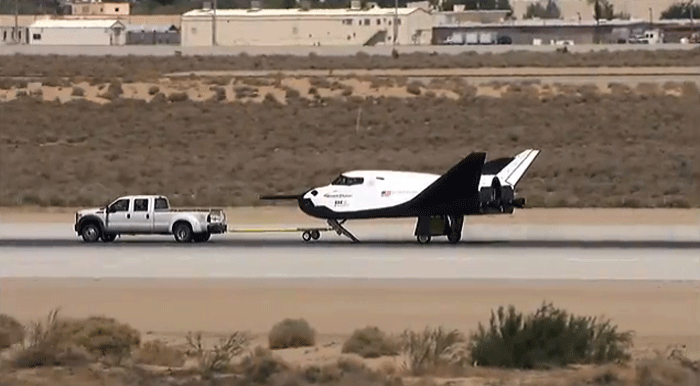
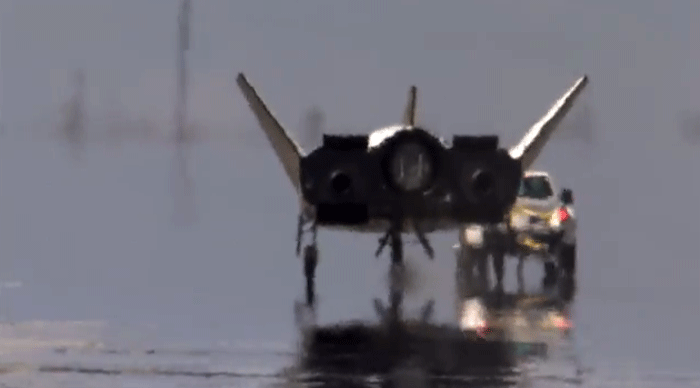






Quelle: SNC
.
Update: 9.01.2014
.
European Space Agency Could Contribute Hardware to SNC's Dream Chaser Spaceplane
PARIS — The European Space Agency (ESA), following in the footsteps of the German space agency, DLR, on Jan. 8 said it had signed an agreement with Sierra Nevada Corp. to investigate a European collaboration on SNC’s Dream Chaser crew-transport vehicle.
The 20-nation ESA said the one-year study with Sparks, Nev.-based SNC will focus on ESA-developed hardware that could be integrated into the Dream Chaser, reducing SNC’s development costs.
One specific focus, the agency said, will be ESA’s International Berthing Docking Mechanism, being developed in Belgium, Italy and Switzerland for use at the international space station and in future international space exploration missions.
The German Aerospace Center, DLR, in November concluded an agreement with OHB AG’s Kayser-Threde division in Munich to use German national funding for a similar study, this one focusing on Dream Chaser’s adaptability as a satellite-launch and satellite-recovery platform in orbits higher than the international space station.
Bremen, Germany-based OHB, a major space hardware contractor, said a Europeanized Dream Chaser, called DC4EU — Dream Chaser for European Utilization — could be used to ferry astronauts and gear to the space station.
ESA, Germany and the other partners in the international space station — the United States, Russia, Japan and Canada — have agreed to continue operating the orbital complex until 2020 and are discussing whether to extend the station’s life to 2028. OHB said the Dream Chaser vehicle, being developed by SNC as part of NASA’s Commercial Crew Program, could assure Europe a role in manned space activities after the station is decommissioned.
Quelle: Spacenews
.
Sierra Nevada Corporation Announces International Expansion
of the Dream Chaser® Space System
Sparks, Nev., January 8, 2014 – In a press conference today, Sierra Nevada Corporation (SNC) announced the global expansion of the Dream Chaser® Space System through recently finalized cooperative understandings with the European Space Agency (ESA) and the German Aerospace Center (DLR). SNC will work with each agency on the potential application of European technologies to both the current Dream Chaser design, and advanced derivative versions of the vehicle. This international collaboration will also help define missions outside the Dream Chaser’s primary mission of ferrying U.S. and partner nation astronauts to low-Earth orbit, thereby helping to maintain the global space partnerships established between these agencies and the United States space program.
Through these understandings, ESA and DLR will join the expanding SNC team and add European expertise to further advance the development of the Dream Chaser Space System. At the same time having access to Dream Chaser flights will enable European countries to advance their space technologies, flight opportunities and space interests in low-Earth orbit.
“Today marks a special day for SNC,” said Mark Sirangelo, corporate vice president and head of SNC’s Space Systems. “With the start of these new relationships with ESA and DLR we are able to continue to expand the Dream Chaser Space System globally. The combined strengths of our partner space agencies, industrial companies and education institutions will significantly advance space education, exploration and, for various missions such as microgravity science, spacecraft servicing, debris removal, and materials manufacturing, provide economic benefits to all partners and strengthen U.S. and international ties.”
SNC’s Dream Chaser Space System is at the forefront of the commercial human spaceflight industry offering safe, reliable and cost-effective crew and critical cargo transportation services to low-Earth orbit. As the only lifting-body, low-g reentry spacecraft with the capability to land on commercial runways, anywhere in the world, Dream Chaser is uniquely adaptable to meet a variety of mission requirements, making it the only multi-mission space utility vehicle in the world.
Quelle: SNC
.
HELPING MAKE DREAM CHASER A REALITY
.
ESA and American company Sierra Nevada Corporation (SNC), have signed an understanding to identify areas of collaboration with European industry for developing hardware and mission concepts for the Dream Chaser orbital transportation system.
Dream Chaser is part of NASA’s Commercial Crew Program to transport crew to the International Space Station and back to Earth by 2017. With the aim of developing an economical successor to the Space Shuttle, the Dream Chaser is the only lifting-body vehicle proposed in the programme. It will transport astronauts and critical cargo to low Earth orbit and land like an aircraft on a runway. The spacecraft can also serve as a platform for technology demonstrations, construction and repair in space, as well as a platform for crewed and un-crewed scientific missions.
ESA will work with Sierra Nevada Corporation to identify how European hardware, software and expertise can be used to further the capabilities of the Dream Chaser orbital crew vehicle. ESA and SNC will also study the possibilities for creating an industrial consortium including European partners to use Dream Chaser for European missions.
A major area to be explored is ESA’s International Berthing Docking Mechanism, an advanced docking system designed for use on the International Space Station that would actively capture and seal the vehicle to the orbiting station. The primary build of the system is in Belgium, Italy and Switzerland. A number of other current and developing technologies and processes will also be evaluated including, the use of ESA’s human factors expertise, simulators and cockpit displays and several other key European offerings which are of interest to SNC.
.
Testing International Berthing Docking Mechanism
.
A major area to be explored is ESA’s International Berthing Docking Mechanism, an advanced docking system designed for use on the International Space Station that would actively capture and seal the vehicle to the orbiting station. The primary build of the system is in Belgium, Italy and Switzerland. A number of other current and developing technologies and processes will also be evaluated including, the use of ESA’s human factors expertise, simulators and cockpit displays and several other key European offerings which are of interest to SNC.
This arrangement allows ESA to prove its hardware and technology in space on a crewed spacecraft. In exchange, SNC will have its development costs and production time potentially lessened as well as benefit from the extensive experience of ESA and its industrial partners.
At the end of an initial evaluation and planning phase, which will continue through 2014, the organisations expect to continue the relationship through a long-term agreement leading to flight operations. Both entities foresee further arrangements to continue the partnership towards the potential use of Dream Chaser for European missions.
.
Quelle: ESA / SNC
.
Update: 24.01.2014
.
Erster Orbitalflug der Dream Chaser ® Space System am 1. November 2016.
.
Sparks, Nev., Jan. 23, 2014 – Sierra Nevada Corporation (SNC) announces that it has confirmed that the first orbital flight of its Dream Chaser® Space System will occur on November 1, 2016. Dream Chaser will be brought to orbit on a United Launch Alliance (ULA) Atlas V rocket that is being built in Decatur, Alabama and will launch from Cape Canaveral, Florida.
During SNC’s press event at the John F. Kennedy Space Center (KSC), which was carried live on NASA TV, Mark N. Sirangelo, corporate vice president and head of Sierra Nevada Space Systems also unveiled the plans for Dream Chaser flight operations and vehicle processing in Florida through a detailed multi-part presentation.
Sirangelo started the announcement by saying, “SNC is thrilled to be the first company to confirm a launch date for our country’s return to orbital human spaceflight and the restart of human spaceflight operations from Florida’s Space Coast. We could not have done this without the spirit and engagement from our national and state governments, the best aerospace companies in the industry, and several major universities, which all hail from over 30 states. Together these passionate people will return our astronauts to space on American spacecraft and rockets launched from America’s space coast right here in Florida.”
"Today's announcement is the latest major milestone in the transformation of the Kennedy Space Center into a 21st century launch complex, serving both private sector and government users," said NASA Administrator Charles Bolden. "I salute Kennedy Space Center Director Bob Cabana for his leadership in transitioning the space coast for the future, and applaud Sierra Nevada Corporation on their decision to carry out their ground-breaking work at Kennedy."
"We have been diligent in our efforts, and I consider this a strong vote of confidence from a company that expects to be a major force in the future of human spaceflight," said Bob Cabana, Kennedy center director. "Sierra Nevada Corporation will find in our workforce and facilities the same dynamic and professional people that have made successful missions from here for more than 50 years." Cabana said SNC's involvement with the Florida spaceport shows the conversion to a 21st Century spaceport is succeeding, although work remains to keep the transformation on pace. Also joining in the press conference were:
Michael Gass, United Launch Alliance president and CEO
Frank DiBello, Space Florida president and CEO
Larry Price, Lockheed Martin Space Systems deputy program manager, NASA's Orion spacecraft
Steve Lindsey, Sierra Nevada Corporation senior director and Dream Chaser program manager
“We are honored that Sierra Nevada Corporation has reserved a proven Atlas V to launch its first flight test in 2016,” said Michael Gass, United Launch Alliance president and CEO. “With 42 successful missions spanning a decade of operational service, the commercially-developed Atlas V is uniquely qualified to provide launch services for the Crew Transportation System. Because Atlas is already certified by NASA to fly the nation’s most complex exploration missions, ULA is able to provide a wealth of flight data, design implementation, detailed system and sub-system analysis, qualification and certification documentation to support NASA certification of the Atlas V for human space flight.”
In addition to confirming the launch, SNC also highlighted its plans to employ the Operations and Checkout (O&C) facility at NASA’s KSC. The O&C facility will be used for both preparation of the reusable Dream Chaser spacecraft for its flights and post-mission testing for its next flight. The O&C is an historic facility for America’s space program, which was originally built to process Gemini and Apollo era spacecraft. After significant upgrades by NASA and the State of Florida, it is currently being used by Lockheed Martin Space Systems to develop, assemble and test NASA’s Orion spacecraft. James H. Crocker, Vice President and General Manager, Civil Space, Lockheed Martin Space Systems commented about the joint efforts, “The O&C is a state-of-the-art facility that will greatly enhance Dream Chaser’s future operations through an innovative co-use plan with Orion. The result will maximize efficiency for both Dream Chaser and Orion and will provide continuity for our highly trained, motivated and certified workforce.”
The third part of SNC’s announcement underscored Dream Chaser’s intended use of NASA’s Shuttle Landing Facility (SLF). The SLF is an airport/spaceport located on Merritt Island in Brevard County, Fla. The SLF is part of KSC and was used by NASA's Space Shuttle for landing until the program's end in 2011. The facility is also used for takeoffs and landings for NASA training jets and civilian aircraft, such as the Shuttle Carrier Aircraft. Frank DiBello, CEO of Space Florida, provided his view, “Today’s announcement by Sierra Nevada Corporation continues to verify a strong commercial interest in the SLF,” said Space Florida President Frank DiBello. “It is clear that the future growth of commercial space is happening here in Florida and we couldn’t be happier to work with SNC to realize their Florida-based expansion goals.”
In closing, Steve Lindsey, SNC’s senior director and Dream Chaser program manager, added his final thoughts, “I had the privilege of piloting and commanding five Space Shuttle flights as a NASA astronaut. This included the last flight of Discovery which was processed, launched, and on March 9, 2011, made its final landing at the SLF after 39 flights and 148 million space miles. Mark, the entire SNC Dream Chaser team, and I look forward to seeing Dream Chaser continue this legacy from Discovery when it flies in 2016.”
.
A model of Sierra Nevada's Dream Chaser spacecraft sits next to a plaque marking the last landing of space shuttle Discovery at the Kennedy Space Center's Shuttle Landing Facility. (NASA)
.
Quelle: SNC
.
Update: 31.01.2014
.
Sierra Nevada Corporation Enters Dream Chaser® Critical Design Review
Completes NASA CCiCap CDR Entry Milestone
.
Sparks, Nev., January 30, 2014 – Sierra Nevada Corporation (SNC) announces the completion of the Dream Chaser® Incremental Critical Design Review (CDR) with the completion of Milestone 10a under its Commercial Crew Integrated Capability (CCiCap) agreement with NASA.
Mark N. Sirangelo, corporate vice president and head of SNC’s Space Systems made the announcement at the Annual Reliability and Maintainability Symposium (RAMS®) during his keynote address. RAMS is the premier event in the reliability, availability, and maintainability engineering disciplines. The RAMS event attracted hundreds of safety and reliability practitioners and engineering leaders from around the world.
“SNC’s Dream Chaser program continues its steady progress forward on the way to flight certification by completing this important milestone which begins our Dream Chaser Critical Design Review process,” said Sirangelo. “SNC is firmly committed to providing the safest, most reliable, and efficiently maintainable orbital transportation system with, the Dream Chaser Space System, by having the most experienced technical, safety, reliability and quality assurance team possible. The team is definitely ensuring that we incorporate the latest technology from all of these processes into SNC’s design.”
NASA added Milestone 10a to SNC’s CCiCap initiative in 2013 as part of the expansion of SNC’s program. During this entry milestone review, NASA approved the critical design products, plans, and processes that are being used to develop the Dream Chaser Space System (DCSS), which includes the Dream Chaser spacecraft, Atlas launch vehicle, mission and ground systems. The CDR level products will also support the subsystem and element critical design reviews that are occurring throughout the year and culminating with system level reviews scheduled to ensure all technical performance requirements are met while meeting Dream Chaser Program schedule and budget. The DCSS fabrication, assembly, integration, and test process has begun to support the recently announced November 2016 orbital launch.
John Turner, SNC’s director of safety and mission assurance for the Dream Chaser program, and member of the RAMS management committee added his thoughts, “I had the privilege of spending over 26 years at NASA working on planning, development, operations and safety aspects of the space shuttle, International Space Station, and Constellation Human Spaceflight programs. My main focus was and remains to ensure that all flight programs were safe, successful and exceeded mission targets. We are incorporating those best practices and lessons learned into our CDR processes for the Dream Chaser. We also have a world class team with strong experience in safety and risk management to ensure that we certify Dream Chaser as the safest human spaceflight vehicle yet to fly.”
David Oberhettinger, the general chair of the RAMS® 2014 symposium held in Colorado Springs, Colo., noted, “RAMS® is excited to have companies like SNC participate in our annual conference and benefit from the unique opportunities that we offer. Conference participants gain insights into latest advances in the field of reliability and maintainability than can be immediately applied to assure high product reliability, safety and mission success.”
Quelle: SNC
.
Update: 1.03.2014
.
Louisville, Colo., February 28, 2014 – Sierra Nevada Corporation (SNC) announces the successful completion of a flight-profile data review milestone for its Dream Chaser® spacecraft.
Completed under the Commercial Crew Integrated Capability (CCiCap) agreement, Milestone 4a gave engineers the opportunity to review data from the Dream Chaser flight test that was conducted at Edwards Air Force Base, Calif., in collaboration with NASA’s Dryden Flight Research Center. To date, SNC has completed over 70 percent of its CCiCap agreement total award value, receiving 100 percent of the milestone value awarded for each milestone completed.
The Milestone 4a flight test objectives included the collection of all nominal glide slope and other critical aerodynamic data for the Dream Chaser in-flight profile. The Dream Chaser team collected and evaluated data gathered from additional aerodynamic modeling instrumentation sensors specifically placed onto the Dream Chaser spacecraft prior to the flight test. Upon thorough post flight analysis conducted by the SNC team and review by NASA, the results validated the aerodynamic performance of the Dream Chaser and significantly matured its aerodynamic database in the subsonic region of flight. In addition to demonstrating the Dream Chaser spacecraft’s autonomous flight control system in Milestone 4a, the Dream Chaser team was able to authenticate that over 40 aerodynamic predictions from extensive analysis matched within the limits of the actual vehicle performance.
Mark Sirangelo, corporate vice president and head of SNC’s Space Systems said, “Milestone 4a proved the Dream Chaser flies well and that the path the Dream Chaser will take throughout its expected flight profile can be reliably predicted. SNC was able to show NASA that our trajectory analysis and flight performance modeling tools and techniques were able to accurately forecast the flight performance of Dream Chaser from the start of free flight through runway touchdown. Now that we have successfully passed a second flight-based milestone we have further reassurance that our vehicle design is sound and that our spacecraft can successfully fly within established and expected flight boundaries. We are now advancing and upgrading the Dream Chaser test spacecraft in preparation for additional expanded flight tests in 2014.”
SNC is working with NASA’s Commercial Crew Program to develop a safe, innovative, modern, flexible and highly-capable crew transportation system for the 21st Century. Dream Chaser provides the only reusable, human-rated lifting-body spacecraft with a commercial runway landing capability, anywhere in the world, and is on the forefront of the commercial human spaceflight industry, offering safe, reliable and cost-effective crew and critical cargo transportation to low-Earth orbit.
Quelle: SNC
.
Update: 21.05.2014
.

Sierra Nevada Corporation Completes Critical Wind Tunnel Tests for Dream Chaser® Spacecraft
Sparks, Nev., May 19, 2014 – Sierra Nevada Corporation (SNC) announces the successful completion of the latest milestone in its NASA Commercial Crew Integrated Capability (CCiCap) agreement. NASA awarded SNC full value of $20 million for the passage of CCiCap Milestone 8, Wind Tunnel Testing. To date, SNC has received over 80 percent of the total award value under the CCiCap agreement and is on track to complete the program later this year.
The purpose of Milestone 8 was to continue to advance the overall design of the Dream Chaser® orbital spacecraft by analyzing the forces and flight dynamic characteristics that the vehicle will experience during orbital ascent and re-entry. The completion of this milestone significantly advances the path to orbital flight of the Dream Chaser spacecraft and the Dream Chaser Atlas V integrated launch system. Several Dream Chaser scale model spacecraft were subjected to multiple different wind tunnel tests in various configurations, including the integrated Dream Chaser attached to the United Launch Alliance Atlas V launch vehicle. In addition to the baseline milestone criteria, SNC fully self-funded an additional wind tunnel test that will accelerate the Dream Chaser development schedule and path to completion of the Critical Design Review.
“The aerodynamic data collected during these tests has further proven and validated Dream Chaser’s integrated spacecraft and launch vehicle system design. It also has shown that Dream Chaser expected performance is greater than initially predicted,” said Mark N. Sirangelo, corporate vice president and head of SNC’s Space Systems. “Our program continues to fully complete each of our CCiCap agreement milestones assisted through our strong collaboration efforts with our integrated ‘Dream Team’ of industry, university and government strategic partners. We are on schedule to launch our first orbital flight in November of 2016, which will mark the beginning of the restoration of U.S. crew capability to low-Earth orbit.”
The wind tunnel tests for this milestone were completed at NASA’s Ames Research Center in Moffett Field, California, CALSPAN Transonic Wind Tunnel in New York, and at NASA’s Langley Research Center Unitary Plan Wind Tunnel in Hampton, Virginia. SNC has a long standing relationship with Langley dating to 2004, the beginning of its development for the Dream Chaser, a derivative of NASA’s HL-20 lifting body vehicle. Langley also houses the full motion-based flight simulator, which operates using Dream Chaser flight software and has been used to train future Dream Chaser pilots and NASA astronauts. In addition to these locations, previous wind tunnel testing also occurred at NASA’s Marshall Space Flight Center in Huntsville, Alabama and at Texas A&M University.
SNC is working with NASA’s Commercial Crew Program to develop a safe, innovative, modern, flexible and highly-capable crew transportation system for the 21st Century. Dream Chaser provides the only reusable, human-rated lifting-body spacecraft with a commercial runway landing capability, anywhere in the world, and is on the forefront of the commercial human spaceflight industry, offering safe, reliable and cost-effective crew and critical cargo transportation to low-Earth orbit. Dream Chaser is a multi-mission capable spacecraft that has the ability to work as an independent science platform, or as a logistics vehicle to retrieve, repair, replace, assemble or deploy items in space.
Quelle: SNC
.
Update: 23.07.2014
.
SNC Dream Chaser erreicht weiteren CCiCap Milestone 9

This week, Sierra Nevada Corporation Space Systems (SNC), one of three private companies currently developing spacecraft with NASA funds to ferry crews to and from the International Space Station, successfully completed Milestone-9 in the development of their Dream Chaser under the company’s Commercial Crew Integrated Capability agreement (known as CCiCap) with the space agency.
The major comprehensive review, known as the Risk Reduction and Technology Readiness Level (TRL) Advancement Testing milestone, subjected five specific Dream Chaser systems to the extensive testing.
From SNC:
The comprehensive Milestone 9 systems tests that were conducted included:
Thermal Protection System: Extensive design qualification testing was conducted at NASA’s Ames Research Center in California and NASA’s Langley Research Center in Virginia through existing Space Act Agreements to validate TPS design performance. This effort included over 350 tests that allowed SNC to select the optimal TPS architecture for Dream Chaser to safely fly through the high-heat-load atmospheric environment during nominal return to Earth as well as during high altitude ascent aborts.
Structures: Numerous tests were conducted in collaboration with SNC Dream Team member Lockheed Martin at NASA’s Michoud Assembly Facility in Louisiana. More than 1,500 stress tests were executed on the primary structure to fully validate the strength and reliability of the Dream Chaser advanced composite structure.
Crew Systems: Multiple tests were performed at SNC’s Space Systems headquarters in Louisville, Colorado. These crew-related assessments included reach and visibility, as well as crew ingress and egress testing in the horizontal and vertical positions, all in the new full-scale Dream Chaser crew cabin mockup. Over 25 tests were conducted totaling more than 90 hours of data.
Environmental Control and Life Support Systems: Human-in-the-loop tests were performed to analyze temperatures and metabolic rates for crew as part of an in-orbit simulation at Orbital Technologies Corporation (ORBITEC) of Wisconsin in conjunction with their teammate UTC Aerospace in Connecticut.
Thermal Control System: Both internal and external active thermal control of the spacecraft was successfully demonstrated through rigorous testing by Orbitec at their facilities.
The completion of Milestone-9 marks the second CCiCap milestone SNC has completed in less than a month, as just a couple weeks ago the company completed Milestone-9a, which subjected Dream Chaser’s Main Propulsion System and Reaction Control System to similar Risk Reduction and TRL advancement tests. Over 3,500 tests have been conducted over the course of the last year during both Milestones 9 and 9a, and with this week’s completion of Milestone-9, SNC has now received 92 percent of the total award value of the CCiCap agreement.
“By thoroughly assessing and mitigating each of the previously identified design risks, SNC is continuing to prove that Dream Chaser is a safe, robust, and reliable spacecraft,” said Mark Sirangelo, corporate vice president of SNC’s Space Systems. “These crucial validations are vital steps in our Critical Design Review and in showing that we have a very advanced and capable spacecraft. This will allow us to quickly and confidently move forward in restoring cutting-edge transportation to low-Earth orbit from the U.S.”
The Dream Chaser’s potential as a reusable lifting-body (winged glider) spacecraft is unique—no other company is developing anything similar. Dream Chaser will have no abort blackout zones and a 3.5-day free-flight capability—with the added benefit of deorbiting at any time (since Dream Chaser can land on any conventional runway, not just the SLF). The spacecraft will also be able to stay at the International Space Station (ISS) for up to seven months at a time, if needed, before having to return to Earth, and an expected 1.5 G nominal reentry will provide ideal conditions for returning fragile cargo and science experiments, in addition to making the return to gravity easier on the crew (SNC expects immediate access to crew and cargo upon landing). A quick turnaround and an almost entirely reusable vehicle put Dream Chaser in a class all its own.
That is, of course, assuming SNC advances to the second phase of NASA’s Commercial Crew Program (CCP) later this year, when the space agency is expected to award at least one of the three companies hoping to return U.S. astronauts to the ISS from American soil a Commercial Crew Transportation Capability (CCtCap) agreement.
The company, assuming again that they advance with NASA’s CCP and earn a CCtCap award, hopes to launch their first autonomous orbital spaceflight in 2016 atop a United Launch Alliance (ULA) Atlas-V 402 rocket, with the first crewed mission to launch in the third quarter of 2017. The company expects to eventually base a fleet of dream Chaser’s, each with unique capabilities, out of Florida’s historic launch sites at Kennedy Space Center and Cape Canaveral Air Force Station.
“Our partners are making great progress as they refine their systems for safe, reliable and cost-effective spaceflight,” said Kathy Lueders, manager of NASA’s Commercial Crew Program. “It is extremely impressive to hear and see the interchange between the company and NASA engineering teams as they delve into the very details of the systems that help assure the safety of passengers.”
Dream Chaser has flown once so far, an autonomous free flight test over Edwards Air Force Base. A second autonomous free-flight test, known as ALT-2, is planned to take place at Edwards again later this year before the company conducts its first piloted Dream Chaser free flight test. No specific date(s) have been announced by SNC for those flights yet.
Quelle: AS
.
Update: 3.12.2014
.
Sierra Nevada Corporation Successfully Tests Critical
Dream Chaser® Spacecraft Propulsion System
Completes CCiCap Milestone 15a
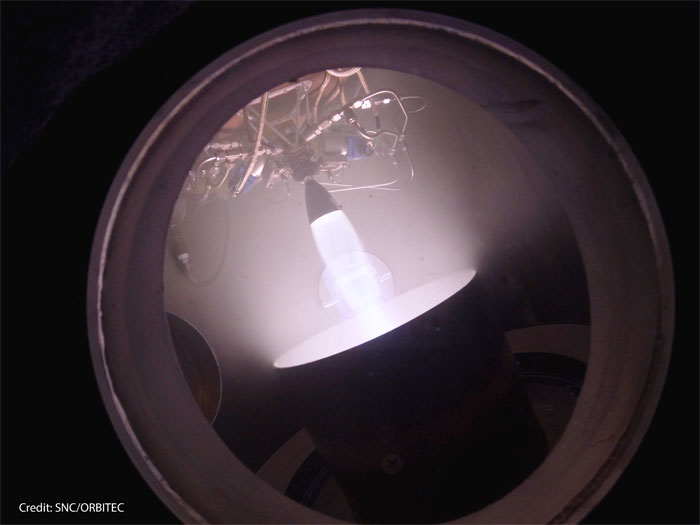
SNC and ORBITEC complete RCS testing in vacuum chamber to simulate orbit environment
.
Sierra Nevada Corporation (SNC) announces the successful completion of a major milestone relating to the Reaction Control System (RCS) propulsion risk reduction for the Dream Chaser® Space System, known as Milestone 15a. The achievement further matures the design toward Critical Design Review (CDR) and positions SNC one step closer to concluding all milestones laid out in NASA’s Commercial Crew Integrated Capability (CCiCap) agreement. To date, SNC has received 96 percent of the total award value of the CCiCap agreement, having successfully completed 12 of 13 milestones.
Milestone 15a builds on SNC’s previous propulsion system innovation and development maturity by implementing a compact prototype thruster operating in a vacuum chamber to simulate an on-orbit environment. The RCS, which is being designed and tested by SNC’s wholly-owned subsidiary, Orbital Technologies Corporation (ORBITEC), provides precise on-orbit control of the Dream Chaser spacecraft for many critical maneuvers including docking of the Dream Chaser spacecraft to destinations in low-Earth orbit. The RCS also supports the unique capability of the Dream Chaser to safely return from orbit and land on any designated runway.
“Safety is paramount in the design of the Dream Chaser Space System,” said Mark N. Sirangelo, corporate vice president of SNC’s Space Systems. “It is driven by reliability, rigorous quality assurance, consistent performance, extensive testing, and robust analysis. In passing this milestone, we are able to validate our performance and safety, while decreasing the risk for this critical propulsion system. Reaching this milestone propels us even closer toward the Critical Design Review and orbital flight of our complete system.”
On August 19, 2013, SNC and NASA amended their original CCiCap Space Act Agreement to add Milestones 15a. The optional milestone provided critical hardware demonstration of the RCS technology to support crewed or uncrewed missions of the Dream Chaser Space System architecture.
SNC’s Dream Chaser is a multi-mission-capable space utility vehicle that is able to operate as an independent science platform, logistics enabler, or orbital servicing vehicle with the ability to retrieve, repair, replace, assemble or deploy items in space. Dream Chaser provides the only reusable, human-rated, lifting-body spacecraft with a commercial runway landing capability, anywhere in the world -
7129 Views




